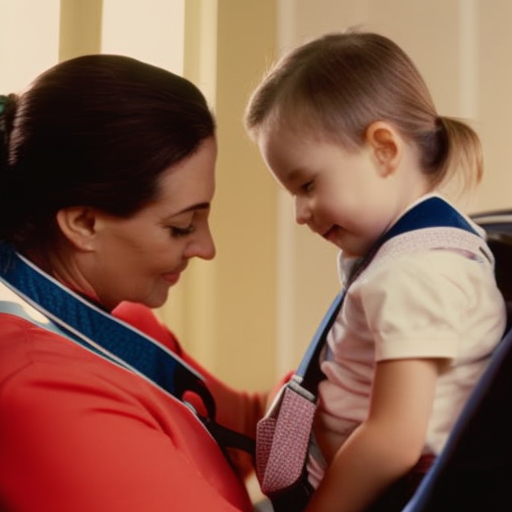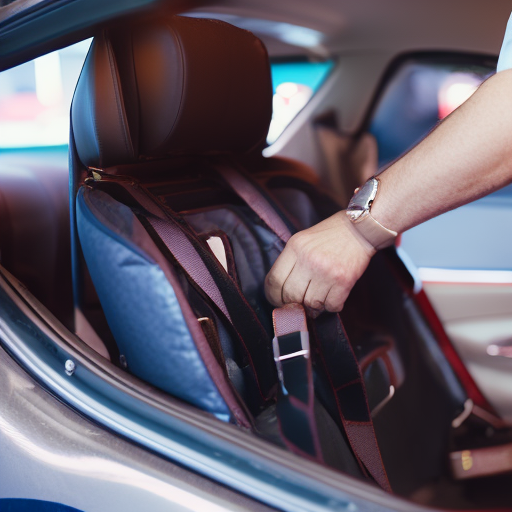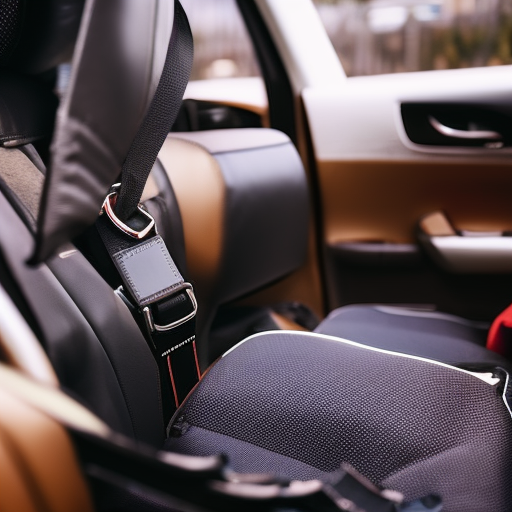"Cherishing Little Steps - A Haven for Baby and Family Journeys"
Ensuring Safety in Car Seats
Are you ready to embark on a journey to ensure the safety of your little ones while on the road?
Just like a warm and comforting hug, car seats are designed to keep your precious cargo secure and protected.
In this guide, we will explore the essential steps to guarantee the utmost safety in car seats.
From proper installation techniques to selecting the right seat for your child’s age and size, we’ve got you covered.
We’ll also delve into adjusting straps and buckles for a snug fit, installing car seats in different vehicles, and expert recommendations to ensure your peace of mind.
So, let’s buckle up and prioritize the safety of your loved ones on every ride!
Key Takeaways
- Proper installation and harnessing techniques are crucial for ensuring the safety of car seats.
- Choosing the right car seat based on your child’s age, weight, and height is important.
- Rear-facing seats provide better protection for young children, while forward-facing seats pose higher risks.
- It is essential to follow expert recommendations, check for recalls, and perform regular maintenance on car seats.
Importance of Proper Installation

To ensure the safety of your child, it’s crucial that you properly install your car seat. Proper installation is the foundation of car seat safety, and it can significantly reduce the risk of injury in the event of a crash.
Follow these tips to ensure your car seat is installed correctly.
First, carefully read the manufacturer’s instructions. Each car seat model may have specific installation requirements, so it’s important to familiarize yourself with them. Look for safety certifications on the car seat, such as the National Highway Traffic Safety Administration (NHTSA) label or the Juvenile Products Manufacturers Association (JPMA) seal. These certifications indicate that the car seat has passed rigorous safety tests.
Next, choose the appropriate installation method for your car seat. There are two common methods: the LATCH system and the seat belt installation. The LATCH system uses anchor points in the vehicle to secure the car seat, while the seat belt installation involves threading the seat belt through the car seat and locking it in place. Follow the instructions provided by the manufacturer to ensure proper installation using your chosen method.
Lastly, make sure the car seat is tightly installed. There should be minimal movement when you try to wiggle the car seat. Check the tightness of the straps and adjust them accordingly. Double-check all the connections and ensure that the car seat is level with the ground.
By following these proper installation tips and checking for safety certifications, you can rest assured that your child is protected in their car seat.
Correct Harnessing Techniques
Properly harnessing your child in the car seat is essential for their safety, building upon the importance of proper installation discussed previously.
To ensure your child is securely harnessed, follow these correct harnessing techniques:
-
Proper positioning: Make sure the harness straps are at the correct height. For rear-facing seats, the straps should be at or below your child’s shoulders. For forward-facing seats, the straps should be at or above the shoulders. Adjust the harness tightness so that you can just fit two fingers between the straps and your child’s collarbone.
-
Safety standards: Always use the harness system provided by the car seat manufacturer. Avoid using aftermarket products, such as strap covers or pads, as they can interfere with the harness’s effectiveness. Also, be aware of weight limits and height restrictions specified by the car seat manufacturer. It’s crucial to adhere to these safety standards to ensure your child is properly protected.
-
Tighten and snug: After securing your child in the car seat, tighten the harness straps until they’re snug. A snug harness prevents excessive movement during a collision. Check for proper tightness by performing the ‘pinch test’ – if you can pinch any excess strap material between your fingers, the harness is too loose and needs to be tightened.
-
Regular checks: Regularly inspect the harness straps for any signs of wear and tear, such as fraying or stretching. If you notice any damage, replace the harness immediately to ensure your child’s safety.
Choosing the Right Car Seat
When selecting a car seat, it’s important to regularly evaluate your child’s needs and make adjustments as they grow. The first step in choosing the right car seat is to consider your child’s age, weight, and height. There are different types of car seats available, including rear-facing, forward-facing, and booster seats. Rear-facing seats are suitable for infants and young children, while forward-facing seats are designed for older toddlers and preschoolers. Booster seats are appropriate for older children who’ve outgrown their forward-facing seats.
Once you have determined the type of car seat your child needs, it’s essential to ensure proper installation. Improper installation can compromise the safety of the seat and put your child at risk in the event of an accident. Follow the manufacturer’s instructions carefully and consult with a certified car seat technician if needed. They can provide guidance and assistance to ensure the seat is securely installed in your vehicle.
When it comes to car seat brands, there are numerous options available on the market. Look for reputable brands that have a good safety record and positive customer reviews. Popular car seat brands include Graco, Britax, Chicco, and Evenflo. Consider factors such as ease of use, comfort, and durability when making your decision.
Rear-Facing Vs. Forward-Facing Seats
Evaluate whether a rear-facing or forward-facing seat is the best choice for your child’s safety. When it comes to car seats, the orientation of the seat can have a significant impact on your child’s well-being during a car accident. Here are some key points to consider:
-
Rear-Facing Benefits:
-
Provides better protection for your child’s head, neck, and spine in the event of a crash.
-
Distributes the force of impact over a larger area, reducing the risk of injury.
-
Recommended by experts for infants and young children due to their underdeveloped bodies and fragile bones.
-
Allows for extended rear-facing, which has been proven to be the safest option for children up to a certain age or weight.
-
Forward-Facing Risks:
-
Increases the risk of head and spinal injuries in young children due to the force exerted on their still-developing bodies.
-
Can lead to severe injuries or even fatalities in the event of a frontal collision or sudden stop.
-
May result in injuries to the head, neck, and internal organs due to the abrupt forward movement.
-
Not recommended for children under a certain age or weight, as they’re more vulnerable to injuries in this position.
Considering these factors, it’s crucial to prioritize your child’s safety and choose a car seat that aligns with their age, weight, and developmental stage. Always follow the guidelines provided by car seat manufacturers and consult with a certified child passenger safety technician for expert advice.
Age and Size Recommendations

To ensure your child’s safety in a car seat, it is important to consider the age and size recommendations. These guidelines are designed to provide the best protection for your little one during car rides. By following these recommendations, you can ensure that the car seat is properly fitted and secure, reducing the risk of injury in case of an accident.
Below is a table that outlines the age and weight guidelines for car seats:
| Age Range | Weight Range |
|---|---|
| Newborn-2 years | 5-40 pounds |
| 2-4 years | 20-65 pounds |
| 4-8 years | 40-100 pounds |
| 8-12 years | 80-120 pounds |
| 12 years and older | 120 pounds and above |
It’s important to note that these guidelines are just recommendations, and you should always refer to the specific guidelines provided by the car seat manufacturer. Additionally, it is highly recommended to keep your child in a rear-facing car seat for as long as possible, as this position offers the most protection in case of a collision. The benefits of extended rear-facing include reduced risk of head and neck injuries, as well as better support for the spine and developing bones.
Checking for Recalls and Expiration Dates
To ensure the ongoing safety of your child in a car seat, it’s essential that you regularly check for any recalls or expiration dates. This will help you stay informed about any potential safety issues and ensure that your child’s car seat is still effective and reliable. Here are a few important points to consider:
-
Recalls awareness: Stay vigilant and keep an eye out for any recalls issued by the car seat manufacturer. These recalls are usually made to address safety concerns or defects that have been identified in the product. By staying aware of recalls, you can take the necessary steps to address any issues promptly.
-
Expiration date importance: Car seats have an expiration date, usually printed on a label attached to the seat. This date is important because the materials and components of the seat can degrade over time, reducing their ability to protect your child in the event of a crash. It’s crucial to replace the car seat once it reaches its expiration date to ensure maximum safety.
-
Regularly check for recalls: Make it a habit to regularly check for any recalls for your specific car seat model. You can visit the manufacturer’s website or sign up for email notifications to stay informed about any safety recalls.
-
Monitor the expiration date: Keep track of the expiration date of your child’s car seat. Mark it on your calendar or set a reminder on your phone to ensure that you replace the seat before it expires.
Common Mistakes to Avoid

To ensure the ongoing safety of your child in a car seat, it is important to be aware of common mistakes that should be avoided. Proper installation is crucial for the effectiveness of a car seat, and making these mistakes can put your child at risk. Here are some common mistakes to avoid:
| Common Mistakes | Proper Installation |
|---|---|
| Incorrect seat angle | Use the recline angle specified by the manufacturer. Adjust the angle as your child grows. |
| Loose harness straps | Ensure that the harness straps are snug and secure. The "pinch test" can help determine if the straps are tight enough. |
| Forward-facing too soon | Keep your child in a rear-facing position until they reach the maximum weight or height limit recommended by the manufacturer. |
| Incorrect seat belt routing | Follow the car seat’s instruction manual to correctly route the seat belt or LATCH system through the car seat. |
Importance of Regular Maintenance

As you strive to ensure the ongoing safety of your child in a car seat, it’s crucial to understand the importance of regular maintenance. By following these regular maintenance tips, you can keep your child’s car seat in optimal condition and provide them with the utmost protection:
-
Inspect the car seat regularly: Check for any signs of wear and tear, such as frayed straps or broken buckles. Replace any damaged parts immediately to maintain the seat’s integrity.
-
Clean the car seat regularly: Remove the cover and wash it according to the manufacturer’s instructions. Wipe down the seat’s surface with a mild detergent and water solution to remove any dirt or spills.
-
Adjust the harness straps: As your child grows, make sure to adjust the harness straps to ensure a secure fit. The straps should be snug but not too tight, with the chest clip positioned at armpit level.
-
Follow the manufacturer’s guidelines: Read the car seat’s instruction manual thoroughly and follow the recommended maintenance schedule. This will help you avoid common maintenance mistakes and ensure that your child’s car seat remains safe and reliable.
Regular maintenance is essential for keeping your child safe in their car seat. By incorporating these tips into your routine, you can have peace of mind knowing that your child is protected during every car ride.
Adjusting Straps and Buckles for a Secure Fit

Ensure a secure fit by properly adjusting the straps and buckles of your child’s car seat. The straps adjustment and buckle placement are crucial for keeping your child safe and comfortable during car rides.
Here are some steps to help you achieve a secure fit:
-
Straps Adjustment: Start by making sure the straps are at the correct height. For rear-facing seats, the straps should be at or below your child’s shoulders. For forward-facing seats, the straps should be at or above the shoulders. To adjust the straps, simply slide the adjuster up or down until it’s in the correct position. Ensure that the straps are snug but not too tight, allowing for one finger to fit between the straps and your child’s collarbone.
-
Buckle Placement: The buckle should be positioned at your child’s chest level. Make sure the buckle is securely fastened and that the harness is properly threaded through it. Check for any twists or tangles in the straps and adjust them accordingly. It’s important to note that the chest clip should be at armpit level to prevent the straps from slipping off the shoulders in case of an accident.
By following these simple steps, you can ensure that your child’s car seat is properly adjusted for a secure fit.
Remember to regularly check and adjust the straps and buckles as your child grows to maintain their safety and comfort.
Installing Car Seats in Different Vehicles

Securely install car seats in various vehicles to ensure the safety of your child. Installing a car seat can be challenging, especially when dealing with different vehicle types. Here are some tips to help you overcome installation challenges:
-
Check the vehicle manual: Different vehicles have different requirements for car seat installation. Refer to your vehicle’s manual to understand the specific guidelines and recommendations.
-
Use the right installation method: There are various installation methods for car seats, such as using the seat belt or the LATCH system. Ensure that you’re using the correct method for your vehicle type.
-
Adjust the seat angle: Some vehicles have sloped seats, which can affect the angle of the car seat. Use rolled towels or pool noodles to achieve the proper recline angle for your child’s safety.
-
Consider professional help: If you find it difficult to install the car seat correctly, don’t hesitate to seek help from a certified car seat technician. They’ve the expertise to ensure a secure installation in any vehicle type.
Traveling Safely With Car Seats

Make sure you properly secure your child’s car seat to ensure safe travel. When traveling with a car seat, whether by car or airplane, there are a few tips to keep in mind to ensure your child’s safety.
First, check the car seat for any signs of damage or wear and tear before your trip. It’s important to make sure that all the harnesses and buckles are in good working condition. Additionally, always follow the manufacturer’s instructions for installing and securing the car seat. This will help ensure that the car seat is properly installed and provides maximum protection for your child.
When traveling by airplane, it’s important to know the regulations and guidelines set by the airline. Most airlines allow the use of car seats on board, but they may have specific requirements for installation. Some airlines require that car seats be certified for use on aircraft, so it’s important to check with the airline before your trip.
When installing the car seat on the airplane, make sure it’s securely fastened using the seat belt or any provided attachments.
Remember to always use a car seat that’s appropriate for your child’s age, weight, and height. This will ensure that your child is safely restrained during the journey.
Expert Recommendations for Car Seat Safety
When traveling with a car seat, it’s important to follow expert recommendations for maximum safety. Here are some expert opinions and car seat guidelines to keep in mind:
-
Choose the right car seat: Ensure that you select a car seat that’s appropriate for your child’s age, weight, and height. Follow the manufacturer’s guidelines to ensure a proper fit.
-
Install the car seat correctly: Proper installation is crucial for optimal safety. Make use of the vehicle’s seat belt or the LATCH system (Lower Anchors and Tethers for Children) to secure the car seat firmly in place. Double-check that the seat is snug and doesn’t move more than an inch in any direction.
-
Harness your child properly: The car seat harness should be adjusted to fit your child snugly. The chest clip should be positioned at armpit level, and the harness straps should be threaded through the slots at or below your child’s shoulders.
-
Rear-facing for as long as possible: Experts recommend keeping your child in a rear-facing car seat for as long as possible, usually until they reach the maximum height and weight allowed by the car seat manufacturer.
Frequently Asked Questions
What Are the Most Common Mistakes Parents Make When Installing Car Seats?
You often make common mistakes when installing car seats. Proper installation is important to ensure safety. Pay attention to the instructions, secure the seat tightly, and use the correct harness slots.
How Often Should Car Seats Be Checked for Recalls and Expiration Dates?
You should regularly check your car seat for recalls and expiration dates to ensure its safety. It’s important to stay informed and follow car seat installation tips to protect your child on the road.
Are There Any Specific Maintenance Tasks That Should Be Performed Regularly to Ensure Car Seat Safety?
To ensure car seat safety, regularly perform maintenance tasks like checking for loose straps or buckles, cleaning the seat cover, and inspecting for any damage. These simple steps will help keep your child safe on the road.
What Are Some Tips for Adjusting Straps and Buckles to Achieve a Secure Fit?
To achieve a secure fit when adjusting straps and buckles, start by making sure the straps are snug and positioned correctly. Then, fasten the buckle securely, ensuring it clicks into place. Regularly check and adjust as needed for maximum safety.
Are There Any Special Considerations or Tips for Installing Car Seats in Different Types of Vehicles?
Installing car seats in different types of vehicles requires special considerations. For older vehicles, ensure the seat is securely attached to the frame. In larger vehicles, use the lower anchors and tether to achieve a tight fit.
Conclusion
You’ve learned the importance of properly installing and harnessing car seats.
You’ve also learned about choosing the right seat for your child’s age and size.
Additionally, you’ve learned about adjusting straps and buckles for a secure fit.
Remember, safety is paramount when traveling with little ones.
Imagine the peace of mind that comes with knowing your child is protected in their car seat, whether rear-facing or forward-facing.
Follow expert recommendations and ensure your child’s safety on the road.



yandanxvurulmus.Fxptw6BGPYB7
xyandanxvurulmus.B9vtq5xO0Sv7
xbunedirloooo.x9ff7C98kqSI
detachably xyandanxvurulmus.RiELoerTGdmi
allergy medication without side effects allergy pills non drowsy allergy pills over the counter
sleeping pills by price phenergan without prescription
buy deltasone 5mg pill cost deltasone 10mg
medication to decrease stomach acid generic zyloprim 100mg
acne medication pills that work deltasone 10mg for sale dermatologist recommended for acne
strongest prescription allergy medication aristocort buy online tablet for allergy on skin
best medicine for heartburn relief septra usa
order accutane 20mg buy isotretinoin 20mg pills order isotretinoin pills
fuck vurgunyedim.yXRKR04s2J3n
strongest sleeping pills over counter provigil 100mg cheap
amciik siteleri yaralandinmieycan.ey9tcUpluItV
cheap amoxil online cheap amoxicillin pills purchase amoxicillin for sale
buy azithromycin 250mg for sale order generic zithromax zithromax 250mg generic
order gabapentin 800mg online buy gabapentin 600mg
sexax citixx.0mePGVPZP4Wk
porn siteleri hyuqgzhqt.m7pu0SbV7Jjj
craft porn ewrjghsdfaa.kq0lRnFKKXN6
bahis siteleri incest category wrtgdfgdfgdqq.odDJCr1xm11E
azithromycin price order azithromycin for sale oral azipro
buy lasix 100mg online cheap lasix 100mg generic
prednisolone 40mg without prescription buy prednisolone 20mg without prescription cheap prednisolone pills
order amoxicillin 250mg without prescription order amoxicillin 500mg generic amoxicillin buy online
cheap doxycycline 200mg cost vibra-tabs
albuterol inhaler order albuterol 2mg online best allergy medicine for adults
buy amoxiclav buy augmentin generic
generic levoxyl order synthroid 100mcg pill levoxyl online buy
levitra online buy levitra 20mg sale
buy clomiphene 50mg pill clomiphene buy online clomiphene price
generic tizanidine purchase tizanidine pill buy generic tizanidine 2mg
semaglutide 14 mg over the counter rybelsus online order how to buy rybelsus
deltasone 5mg usa buy deltasone 20mg generic prednisone 5mg sale
purchase rybelsus online generic semaglutide 14 mg order semaglutide generic
order accutane 40mg for sale buy isotretinoin 20mg pills order accutane 10mg generic
BİZİ SİK BİZ BUNU HAK EDİYORUZ hepxhupx.19mwqTVKlT05
bahis siteleri incest category juljulfbi.pQXU86ECCvpg
purchase amoxicillin sale order amoxil sale buy generic amoxil
purchase ventolin inhalator for sale albuterol 4mg inhaler purchase albuterol inhalator generic
escort siteleri bjluajszz.S8LgAM0rpv7r
escort bxjluajsxzz.uyVb8WoH5nVs
food porn 0qbxjluaxcxjsxzz.6OR6DGVfqgtI
generic zithromax 250mg order azithromycin 250mg pills purchase zithromax for sale
augmentin 375mg brand clavulanate without prescription order augmentin 1000mg generic
order prednisolone 20mg order omnacortil 40mg online omnacortil 5mg brand
levoxyl medication synthroid 100mcg for sale synthroid 150mcg uk
order gabapentin generic buy gabapentin 600mg for sale gabapentin 100mg oral
buy cheap generic clomiphene purchase serophene pills cheap clomiphene 50mg
buy lasix generic diuretic furosemide 100mg brand order lasix without prescription
sildenafil overnight delivery order sildenafil purchase viagra for sale
acticlate over the counter purchase vibra-tabs without prescription purchase vibra-tabs for sale
buy semaglutide 14 mg online cheap order semaglutide online cheap semaglutide 14mg usa
poker online real money casino games legitimate online slots for money
levitra 10mg generic buy generic levitra online buy vardenafil pill
buy generic lyrica for sale purchase lyrica online cheap lyrica drug
buy plaquenil 400mg sale plaquenil 200mg us buy hydroxychloroquine 200mg online
how to get triamcinolone without a prescription aristocort 4mg canada aristocort price
cialis coupon purchase cialis online cheap order cialis
oral clarinex purchase desloratadine pills clarinex 5mg ca
cenforce 100mg oral cenforce tablet generic cenforce
buy loratadine 10mg for sale buy loratadine generic buy claritin without prescription
chloroquine price buy aralen 250mg for sale buy chloroquine generic
porn siteleri pokkerx.QaOlpAUC8n2U
bahis siteleri sikis bingoxx.nNZPHpEpFViN
porno 250tldenemebonusuxx.esgxrKhDiiq1
porn eyeconartxx.VUxyN4xCJJcN
order glycomet 500mg pill glycomet online order metformin 500mg without prescription
orlistat 60mg ca diltiazem online order purchase diltiazem sale
fuck google vvsetohimalxxvc.sHuYQ9AF4zQl
buy acyclovir sale buy allopurinol medication order zyloprim generic
order amlodipine 10mg online cheap buy amlodipine generic order norvasc 10mg pills
rosuvastatin buy online buy zetia paypal ezetimibe price
buy zestril 5mg pills buy zestril pill order lisinopril 2.5mg generic
domperidone 10mg price purchase motilium pill order tetracycline 250mg for sale
order prilosec online prilosec 10mg usa prilosec without prescription
flexeril 15mg cost buy baclofen 10mg generic purchase baclofen generic
metoprolol cheap buy metoprolol 50mg without prescription metoprolol 100mg us
purchase toradol colchicine canada colcrys for sale online
buy tenormin 100mg pills tenormin 50mg cost buy tenormin 100mg generic
http://www.new hd porn.com gghkyogg.1QMPDhKMXfW
porn 4k videos download ggjennifegg.hOFyqubscdU
porn video hd new ggjinnysflogg.sm3tUIKwrIa
fashionflag www free download porn video com fashionflag.BF80IDrawTu
मिल्फ पोर्न के बा hjkvbasdfzxzz.8M1yd4ps4ms
पुरुष हस्तमैथुन अश्लील txechdyzxca.ayPyx4W1lxp
परिपक्व(40 ) पोर्न hkyonet.HTH6Gkdfgs8
ਗਰੁੱਪ ਸੈਕਸ ਬਾਰੇ madisonivysex.VIn3jPglqou
ladesbet ਨੰਗਾ ਨਾਚ ਪੋਰਨ ladesinemi.RMVscXwIZr5
ladesbet 妊娠中のポルノ ladestinemi.Wcioh9Oufew